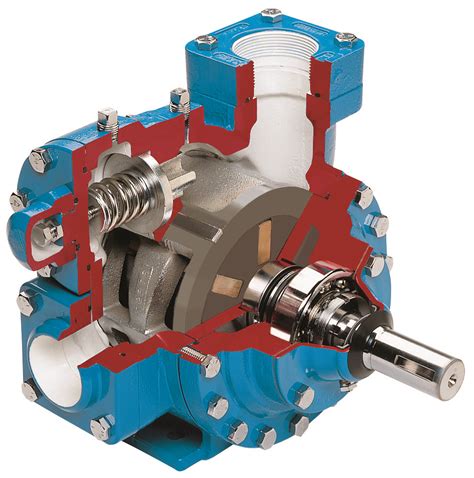Vane Pump Overview

Vane pumps are used successfully in a wide variety of applications. Because of vane strength and the absence of metal-to-metal contact, vane pumps are ideally suited for low-viscosity, nonlubricating liquids up to 2,200 cSt / 10,000 SSU. Such liquids includeLPG, ammonia, solvents, alcohol, fuel oils, gasoline, and refrigerants.
Vane pumps are available in a number of vane configurations including sliding vane (left), flexible vane, swinging vane, rolling vane, and external vane. Vane pumps are noted for their reliability, dry priming, easy maintenance, and good suction characteristics. Moreover, vanes can usually handle fluid temperatures from -32°C / -25°F to 260°C / 500°F and pressures to 30 BAR / 400 PSI.
Each type of vane pump offers unique advantages. For example, external vane pumps can handle large solids. Flexible vane pumps, on the other hand, can only handle small solids but create good vacuum. Sliding vane pumps can run dry for short periods of time and handle small amounts of vapor.
How Vane Pumps Work
Despite the different configurations, most vane pumps operate under the same general principle described below.
- 1. A slotted rotor or impeller is eccentrically supported in a cycloidal cam. The rotor is located close to the wall of the cam so a crescent-shaped cavity is formed. The rotor is sealed into the cam by two sideplates. Vanes or blades fit within the slots of the impeller. As the impeller rotates (yellow arrow) and fluid enters the pump, centrifugal force, hydraulic pressure, and/or pushrods push the vanes to the walls of the housing. The tight seal among the vanes, rotor, cam, and sideplate is the key to the good suction characteristics common to the Vane pumping principle.
- 2. The housing and cam force fluid into the pumping chamber through holes in the cam (small red arrow on the bottom of the pump). Fluid enters the pockets created by the vanes, rotor, cam, and sideplate.
- 3. As the impeller continues around, the vanes sweep the fluid to the opposite side of the crescent where it is squeezed through discharge holes of the cam as the vane approaches the point of the crescent (small red arrow on the side of the pump). Fluid then exits the discharge port.
Advantages
| Disadvantages
|
Applications
- Aerosol/Propellants
- Aviation Service - Fuel Transfer, Deicing
- Auto Industry - Fuels, Lubes, Refrigeration Coolants
- Barge Unloading
- Bulk Transfer of LPG and NH3
- Chemical Process Industry
- LPG Cylinder Filling
- Ethanol/Alcohol Refining
- Fertilizer Production - CO Transfer
- Lubrication Blending - Solvents, Oils
- Mobile Transport - Chemicals, Fuels, LPG, NH3
- Petroleum Industry - Crude Oils and Hydrocarbons
- Power Generation - Fuels, Lubrication
- Pulp and Paper
- Railroad Transfer - Fuels, Lube Oils, Coolant
- Refrigeration - Freons, Ammonia
- Rubber and Plastic
- Seed Refining - Solvents, Oils
- Solvent Distribution
- Textile
Materials Of Construction / Configuration Options
- Externals (head, casing, bracket) - Cast iron, ductile iron, steel, and stainless steel.
- Vane, Pushrods - Viton®, Ryton®, PPS, carbon, Teflon®, and peek.
- Liner & End Plates - Cast iron, ductile iron, steel, carbon, and stainless steel.
- Bearing Cap- Cast iron, ductile iron, steel, and stainless steel.
- Shaft Seal - Component mechanical seals, industry-standard cartridge mechanical seals, and magnetically-driven pumps.
- Packing - Impregnated packing, if seal not required.

Comments